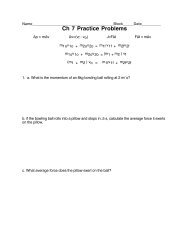circuit notes.cwk
circuit notes.cwk
circuit notes.cwk
You also want an ePaper? Increase the reach of your titles
YUMPU automatically turns print PDFs into web optimized ePapers that Google loves.
Name__________________________________Block_____Date______________<br />
Ch 35 Electric Circuits Notes<br />
<strong>circuit</strong> symbols used in schematic diagrams<br />
Resistors can be connected in series; that is, the current flows through them<br />
one after another. The <strong>circuit</strong> in Figure 1 shows three resistors connected<br />
in series, and the direction of current is indicated by the arrow.<br />
Resistor- an electrical device which offers resistance to the flow of charge.<br />
device where electrical energy is transformed into another form
The type of resistor connection will have a major affect upon the overall<br />
resistance of the <strong>circuit</strong>, the total current in the <strong>circuit</strong>, and the current in<br />
each resistor<br />
pt. A<br />
Series Circuit<br />
pt. B<br />
Parallel Circuit<br />
all devices connected one after the other all devices connected at same 2 pts to voltage source<br />
only 1 path from the ends of batteries each device has its own path from ends of batteries<br />
a single pathway for charge flow multiple pathways for charge<br />
thus current thru ea. device is same<br />
total current divides b/w branches<br />
I = Vbattery / R total Rtot increases I = Vbattery / R total Rtot decreases<br />
I<strong>circuit</strong> = I1 = I2 = I3 I<strong>circuit</strong> = I1 + I2 + I3<br />
Ohm’s law applies sep. to ea. device Ohm’s law applies sep. to ea. branch<br />
-current for ea. determined separately<br />
-current for ea. determined separately<br />
-amt. of current in each ~ 1/ R device -amt. of current in each ~ 1/ R device<br />
-Δ voltage across each decreases -voltage in each device same (all connected<br />
-current across each bulb doesn’t Δ<br />
to same voltage source @ same 2 pts)<br />
(same ratio of ΔV to R I=ΔV/ R)<br />
unscrew 1 bulb > others go out<br />
if current is cut to one; it is cut to all<br />
unscrew 1 bulb > others stay on<br />
increase # of resistors/devices/bulbs: increase # of resistors- adding more branches<br />
chg slows down thru each more paths for charge- flow speeds up<br />
decreases overall resistance> increases current<br />
decreases overall <strong>circuit</strong> current increases overall <strong>circuit</strong> current<br />
bulbs get dimmer<br />
bulbs get brighter<br />
Questions of concern comparing and contrasting series & parallel <strong>circuit</strong>s:<br />
1. As the number of resistors (light bulbs) increases, what happens to the overall current within the<br />
<strong>circuit</strong> Intensity of each bulb<br />
2. As the number of resistors (light bulbs) increases, what happens to the overall resistance within<br />
the <strong>circuit</strong><br />
3. If one of the resistors is turned off (i.e., a light bulb goes out), what happens to the other resistors<br />
(light bulbs) in the <strong>circuit</strong> Do they remain on (i.e., lit)
Parallel Circuits<br />
The study of the overall current for parallel connections requires the<br />
addition of an indicator bulb. The indicator bulb is placed outside of the<br />
branches and allows one to observe the affect of additional resistors upon<br />
the overall current<br />
With each increase in a branch with a light bulb, the overall resistance for<br />
the <strong>circuit</strong> drops. There are more options for the charge to flow, actually<br />
increasing the rate of flow of charge (increasing the current!)<br />
all devices connected at same 2 pts to voltage source<br />
pt. A<br />
pt. B
















